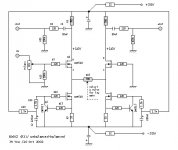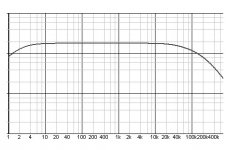Tak, Henrik.
I will re-post BSOZ tonight (our time). Please give me your
input again. I would much appreciate.
I will re-post BSOZ tonight (our time). Please give me your
input again. I would much appreciate.
Well, Nelson, In order to approach closer to the perfectly equal
output amplitude, I adopted the constant current source (CCS)
instead of the plain resistors for the tails. Now, it seems that I have
rather solid CCS tails. I however decline the CCS for the upper
resistors. It seems that the upper CCS says less words.
The unbalanced volume control will be at the input stage. Indeed,
the volume at the output offers benefits. But, for the
unbalanced-balanced, the volume at the input is deemed better.
Please kindly take a look, and give me one of your icons.
output amplitude, I adopted the constant current source (CCS)
instead of the plain resistors for the tails. Now, it seems that I have
rather solid CCS tails. I however decline the CCS for the upper
resistors. It seems that the upper CCS says less words.
The unbalanced volume control will be at the input stage. Indeed,
the volume at the output offers benefits. But, for the
unbalanced-balanced, the volume at the input is deemed better.
Please kindly take a look, and give me one of your icons.
Attachments
till
No, I did not think about XP much.
The XP must be very nice and professional. Sure, I could copy it.
As I said at the beginning, however I wanted to find a simple
unbalanced-balanced converter for XSOZV2 posted earlier.
It was not easy. And, through the discussions with Nelson,
I learnt that the constant current sources are necessary
to make a good converter. And, I got to have better understanding
about the function of the constant current source. This is a brief
story of my posts about BOSOZ.
I admit that I am sweating through long way even though
there is a short cut, e.g. copying the XP. I might look stupid
(if you think so). But, I believe that you know why I am doing
this way.
😉
No, I did not think about XP much.
The XP must be very nice and professional. Sure, I could copy it.
As I said at the beginning, however I wanted to find a simple
unbalanced-balanced converter for XSOZV2 posted earlier.
It was not easy. And, through the discussions with Nelson,
I learnt that the constant current sources are necessary
to make a good converter. And, I got to have better understanding
about the function of the constant current source. This is a brief
story of my posts about BOSOZ.
I admit that I am sweating through long way even though
there is a short cut, e.g. copying the XP. I might look stupid
(if you think so). But, I believe that you know why I am doing
this way.
😉
No no, i don´t hink you look stupid, i only thought maybe you would like to have a look at the aleph P to compare, and make a X aleph P or so.
Download SIMetrix simlator, install it, open the attached file an press F9. Then You can see the frequensy responce at Your Scematic.
You can download it from: http://www.newburytech.co.uk/Pages/download.html
You can download it from: http://www.newburytech.co.uk/Pages/download.html
Attachments
Thank you, Henrik.
I did the download. Unfortunately, the program is not working for me.
Even, I could'nt open the file you attached.
I will try it again this evening.
I did the download. Unfortunately, the program is not working for me.
Even, I could'nt open the file you attached.
I will try it again this evening.
A blank icon tells me this and that.
Anyhow, thank you very much, Nelson Pass, indeed.
It seems no more technical comments from experts.
I have neither reliable measurement tools nor good sense of
math. So I would like to rely on the air about the specification.
Yeah, it is time for me to kick off my new building of XSOZV2 (R1)
and BOSOZ (R2). I am going to have steel cutting ceremony
this weekend. Weak idea when I could launch them.
Guys on the floor of this thread, thanks for your allowing
me to use a big stage for my dancing. Now it’s your turn.
I will take just a small part of it.
🙂
Anyhow, thank you very much, Nelson Pass, indeed.
It seems no more technical comments from experts.
I have neither reliable measurement tools nor good sense of
math. So I would like to rely on the air about the specification.
Yeah, it is time for me to kick off my new building of XSOZV2 (R1)
and BOSOZ (R2). I am going to have steel cutting ceremony
this weekend. Weak idea when I could launch them.
Guys on the floor of this thread, thanks for your allowing
me to use a big stage for my dancing. Now it’s your turn.
I will take just a small part of it.
🙂
jh6you
Let´s go for it!
I am sorry that You can´t open the attached file, I have yust tried, and it works for me.
I presume you have installed the winzip program or similar.
You also need the models used in Your scematic, so here they are.
Unzip (Copy) the files to the SIMetrix program directory, wich could be something like "C:\Program files\SIMetrix41Intro\Models" and in the simetrix menu choose "file/model library/re-build catalog", then You should be able to run the scematic by the F9 after opening the simetrix file.
Let´s go for it!
I am sorry that You can´t open the attached file, I have yust tried, and it works for me.
I presume you have installed the winzip program or similar.
You also need the models used in Your scematic, so here they are.
Unzip (Copy) the files to the SIMetrix program directory, wich could be something like "C:\Program files\SIMetrix41Intro\Models" and in the simetrix menu choose "file/model library/re-build catalog", then You should be able to run the scematic by the F9 after opening the simetrix file.
Attachments
-------------------------------------------------------------------
Unzip (Copy) the files to the SIMetrix program directory, wich could be something like "C:\Program files\SIMetrix41Intro\Models" and in the simetrix menu choose "file/model library/re-build catalog", then You should be able to run the scematic by the F9 after opening the simetrix file.
-------------------------------------------------------------------
I did as instructed.
But, still meet errors:
***ERROR***Cannot find definition for MOS model IRFP150
***ERROR***Cannot find definition for BJT model ZTX450
I will re-try.
Unzip (Copy) the files to the SIMetrix program directory, wich could be something like "C:\Program files\SIMetrix41Intro\Models" and in the simetrix menu choose "file/model library/re-build catalog", then You should be able to run the scematic by the F9 after opening the simetrix file.
-------------------------------------------------------------------
I did as instructed.
But, still meet errors:
***ERROR***Cannot find definition for MOS model IRFP150
***ERROR***Cannot find definition for BJT model ZTX450
I will re-try.
I don´t know what´s wrong, but the program can´t find the model, You could check the file extension, it should be *.lib.
Alternatively You could use the buildin models.
Mark the mosfet symbol at the scematic so it turns blue, then right-click on it an choose "edit value" and select IRF130, this one is close to irfp150. Do the same with the bipolar, and choose BC337.
Alternatively You could use the buildin models.
Mark the mosfet symbol at the scematic so it turns blue, then right-click on it an choose "edit value" and select IRF130, this one is close to irfp150. Do the same with the bipolar, and choose BC337.
In my opinion You just got it!
I am buisy for now, so I will not come back before to morrow, then I will try your suggestion in my sim.
All the best!
I am buisy for now, so I will not come back before to morrow, then I will try your suggestion in my sim.
All the best!
- Home
- Amplifiers
- Pass Labs
- x soz





